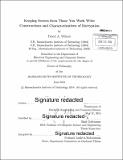| dc.contributor.advisor | Shafi Goldwasser. | en_US |
| dc.contributor.author | Wilson, David A., Ph. D. Massachusetts Institute of Technology | en_US |
| dc.contributor.other | Massachusetts Institute of Technology. Department of Electrical Engineering and Computer Science. | en_US |
| dc.date.accessioned | 2014-10-21T17:26:11Z | |
| dc.date.available | 2014-10-21T17:26:11Z | |
| dc.date.copyright | 2014 | en_US |
| dc.date.issued | 2014 | en_US |
| dc.identifier.uri | http://hdl.handle.net/1721.1/91102 | |
| dc.description | Thesis: Ph. D., Massachusetts Institute of Technology, Department of Electrical Engineering and Computer Science, 2014. | en_US |
| dc.description | 75 | en_US |
| dc.description | Cataloged from PDF version of thesis. | en_US |
| dc.description | Includes bibliographical references (pages 75-82). | en_US |
| dc.description.abstract | given to expanding the models in which encrypted messages are sent (leading to constructions such as identity-based encryption) and the additional functionalities supported by encryption schemes (such as homomorphic operations). This thesis explores the relations between several of these primitives and models, both in terms of generic constructions, and constructions based on specific hardness assumptions. First, we define bounded-collusion identity-based encryption (BC-IBE), a variant of IBE in which the adversary is only allowed to make a limited number of key queries. This restriction allows more general constructions; specifically, we give three distinct generic constructions of BC-IBE from public-key encryption with short ciphertext size. Each of these constructions requires slightly different properties of the underlying public-key scheme; we give specific instantiations of each of these constructions, thus achieving BC-IBE from the DDH, LWE, NTRU, and QR assumptions. Second, we explore the relationship between obfuscation and fully-homomorphic encryption. We define a notion of secure obfuscation for a family of functions known as the f-reencryption functionality, and prove that a secure obfuscator for this functionality generically yields a fully-homomorphic encryption scheme. Furthermore, we relate this new definition to previous definitions of obfuscation, and give an instantiation of such an obfuscator based on the LWE assumption, yielding an FHE construction. | en_US |
| dc.description.statementofresponsibility | by David A. Wilson. | en_US |
| dc.format.extent | 82 pages | en_US |
| dc.language.iso | eng | en_US |
| dc.publisher | Massachusetts Institute of Technology | en_US |
| dc.rights | M.I.T. theses are protected by copyright. They may be viewed from this source for any purpose, but reproduction or distribution in any format is prohibited without written permission. See provided URL for inquiries about permission. | en_US |
| dc.rights.uri | http://dspace.mit.edu/handle/1721.1/7582 | en_US |
| dc.subject | Electrical Engineering and Computer Science. | en_US |
| dc.title | Keeping secrets from those you work with : constructions and characterizations of encryption | en_US |
| dc.type | Thesis | en_US |
| dc.description.degree | Ph. D. | en_US |
| dc.contributor.department | Massachusetts Institute of Technology. Department of Electrical Engineering and Computer Science | |
| dc.identifier.oclc | 892748802 | en_US |
